Investigating Knee Joint Proprioception and Its Impact on Limits of Stability Using Dynamic Posturography in Individuals with Bilateral Knee Osteoarthritis—A Cross-Sectional Study of Comparisons and Correlations
Abstract
1. Introduction
2. Materials and Methods
2.1. Design, Participants, Setting, and Ethics Statement
2.2. Assessments and Outcomes
2.2.1. Knee Pain Severity
2.2.2. Knee Society Score (KSS)
2.2.3. Knee Joint Position Sense
2.2.4. Limits of Stability
2.2.5. Reaction Time
2.2.6. Maximum Excursion
2.2.7. Directional Control
2.3. Statistical Analysis
3. Results
4. Discussion
Limitations
5. Conclusions
Supplementary Materials
Author Contributions
Funding
Institutional Review Board Statement
Informed Consent Statement
Data Availability Statement
Acknowledgments
Conflicts of Interest
References
- Sharma, L. Osteoarthritis of the knee. N. Engl. J. Med. 2021, 384, 51–59. [Google Scholar] [CrossRef] [PubMed]
- Charlesworth, J.; Fitzpatrick, J.; Perera, N.K.P.; Orchard, J. Osteoarthritis—A systematic review of long-term safety implications for osteoarthritis of the knee. BMC Musculoskelet. Disord. 2019, 20, 151. [Google Scholar] [CrossRef] [PubMed]
- Atukorala, I.; Hunter, D.J. A review of quality-of-life in elderly osteoarthritis. Expert Rev. Pharm. Outcomes Res. 2023, 23, 365–381. [Google Scholar] [CrossRef] [PubMed]
- Primorac, D.; Molnar, V.; Rod, E.; Jeleč, Ž.; Čukelj, F.; Matišić, V.; Vrdoljak, T.; Hudetz, D.; Hajsok, H.; Borić, I. Knee osteoarthritis: A review of pathogenesis and state-of-the-art non-operative therapeutic considerations. Genes 2020, 11, 854. [Google Scholar] [CrossRef] [PubMed]
- Grace Gaerlan, M.; Alpert, P.T.; Cross, C.; Louis, M.; Kowalski, S. Postural balance in young adults: The role of visual, vestibular and somatosensory systems. J. Am. Acad. Nurse Pract. 2012, 24, 375–381. [Google Scholar] [CrossRef] [PubMed]
- Ribeiro, F.; Oliveira, J. Aging effects on joint proprioception: The role of physical activity in proprioception preservation. Eur. Rev. Aging Phys. Act. 2007, 4, 71–76. [Google Scholar] [CrossRef]
- Alshahrani, M.S.; Reddy, R.S. Relationship between Kinesiophobia and Ankle Joint Position Sense and Postural Control in Individuals with Chronic Ankle Instability—A Cross-Sectional Study. Int. J. Environ. Res. Public Health 2022, 19, 2792. [Google Scholar] [CrossRef]
- Henry, M.; Baudry, S. Age-related changes in leg proprioception: Implications for postural control. J. Neurophysiol. 2019, 122, 525–538. [Google Scholar] [CrossRef]
- Flowers, D. The Effects of Core Activation and Stabilization Training on Gait Kinetics, Kinematics and Speed and Self-Perceived Function in Patients with Knee Osteoarthritis. Ph.D. Thesis, Texas Woman’s University, Denton, TX, USA, 2020. [Google Scholar]
- Saeed Alshahrani, M.; Reddy, R.S.; Asiri, F.; Tedla, J.S.; Alshahrani, A.; Kandakurti, P.K.; Kakaraparthi, V.N. Correlation and comparison of quadriceps endurance and knee joint position sense in individuals with and without unilateral knee osteoarthritis. BMC Musculoskelet. Disord. 2022, 23, 444. [Google Scholar] [CrossRef]
- Alshahrani, M.S.; Reddy, R.S.; Tedla, J.S.; Asiri, F.; Alshahrani, A. Association between kinesiophobia and knee pain intensity, joint position sense, and functional performance in individuals with bilateral knee osteoarthritis. Healthcare 2022, 10, 120. [Google Scholar] [CrossRef]
- Wei, Z.; Wang, X.-X.; Wang, L. Effect of short-term kinesiology taping on knee proprioception and quadriceps performance in healthy individuals. Front. Physiol. 2020, 11, 603193. [Google Scholar] [CrossRef] [PubMed]
- Xue, Y.-Y.; Shi, J.-N.; Zhang, K.; Zhang, H.-H.; Yan, S.-H. The effects of total knee arthroplasty on knee proprioception of patients with knee osteoarthritis: A meta-analysis. J. Orthop. Surg. Res. 2022, 17, 1–10. [Google Scholar] [CrossRef] [PubMed]
- Arumugam, A.; Björklund, M.; Mikko, S.; Häger, C.K. Effects of neuromuscular training on knee proprioception in individuals with anterior cruciate ligament injury: A systematic review and grade evidence synthesis. BMJ Open 2021, 11, e049226. [Google Scholar] [CrossRef] [PubMed]
- Juras, G.; Słomka, K.; Fredyk, A.; Sobota, G.; Bacik, B. Evaluation of the limits of stability (LOS) balance test. J. Hum. Kinet. 2008, 19, 39–52. [Google Scholar] [CrossRef]
- Jbabdi, M.; Boissy, P.; Hamel, M. Assessing control of postural stability in community-living older adults using performance-based limits of stability. BMC Geriatr. 2008, 8, 8. [Google Scholar] [CrossRef] [PubMed]
- Melzer, I.; Benjuya, N.; Kaplanski, J.; Alexander, N. Association between ankle muscle strength and limit of stability in older adults. Age Ageing 2009, 38, 119–123. [Google Scholar] [CrossRef]
- Clark, S.; Rose, D.J.; Fujimoto, K. Generalizability of the limits of stability test in the evaluation of dynamic balance among older adults. Arch. Phys. Med. Rehabil. 1997, 78, 1078–1084. [Google Scholar] [CrossRef]
- Pickerill, M.L.; Harter, R.A. Validity and Reliability of Limits-of-Stability Testing: A Comparison of 2 Postural Stability Evaluation Devices; National Athletic Trainers’ Association, Inc.: Carrollton, TX, USA, 2011; Volume 46, pp. 600–606. [Google Scholar]
- Wallmann, H.W. Comparison of elderly nonfallers and fallers on performance measures of functional reach, sensory organization, and limits of stability. J. Gerontol. Ser. A Biol. Sci. Med. Sci. 2001, 56, M580–M583. [Google Scholar] [CrossRef]
- Park, H.; Jung, T. Limits of stability, tandem walk, and adaptation test in individuals with symptomatic knee osteoarthritis: A case–control comparison with knee OA and healthy knee controls. Int. J. Hum. Mov. Sport. Sci. 2018, 6, 23–29. [Google Scholar] [CrossRef]
- Ferlinc, A.; Fabiani, E.; Velnar, T.; Gradisnik, L. The importance and role of proprioception in the elderly: A short review. Mater. Socio-Med. 2019, 31, 219. [Google Scholar] [CrossRef]
- Azadinia, F.; Kingma, I.; Mazaheri, M. Effect of external lumbar supports on joint position sense, postural control, and postural adjustment: A systematic review. Disabil. Rehabil. 2022, 45, 753–771. [Google Scholar] [CrossRef]
- Mat, S.; Ng, C.T.; Tan, P.J.; Ramli, N.; Fadzli, F.; Rozalli, F.I.; Mazlan, M.; Hill, K.D.; Tan, M.P. Effect of modified Otago exercises on postural balance, fear of falling, and fall risk in older fallers with knee osteoarthritis and impaired gait and balance: A secondary analysis. PMR 2018, 10, 254–262. [Google Scholar] [CrossRef] [PubMed]
- Kohn, M.D.; Sassoon, A.A.; Fernando, N.D. Classifications in brief: Kellgren-Lawrence classification of osteoarthritis. Clin. Orthop. Relat. Res. 2016, 474, 1886–1893. [Google Scholar] [CrossRef] [PubMed]
- Alghadir, A.H.; Anwer, S.; Iqbal, A.; Iqbal, Z.A. Test–retest reliability, validity, and minimum detectable change of visual analog, numerical rating, and verbal rating scales for measurement of osteoarthritic knee pain. J. Pain Res. 2018, 11, 851–856. [Google Scholar] [CrossRef] [PubMed]
- da Costa, B.R.; Saadat, P.; Basciani, R.; Agarwal, A.; Johnston, B.C.; Jüni, P. Visual Analogue Scale has higher assay sensitivity than WOMAC pain in detecting between-group differences in treatment effects: A meta-epidemiological study. Osteoarthr. Cartil. 2021, 29, 304–312. [Google Scholar] [CrossRef] [PubMed]
- Noble, P.C.; Scuderi, G.R.; Brekke, A.C.; Sikorskii, A.; Benjamin, J.B.; Lonner, J.H.; Chadha, P.; Daylamani, D.A.; Scott, W.N.; Bourne, R.B. Development of a new Knee Society scoring system. Clin. Orthop. Relat. Res. 2012, 470, 20–32. [Google Scholar] [CrossRef]
- Lizaur-Utrilla, A.; Gonzalez-Parreño, S.; Martinez-Mendez, D.; Miralles-Muñoz, F.A.; Lopez-Prats, F.A. Minimal clinically important differences and substantial clinical benefits for Knee Society Scores. Knee Surg. Sport. Traumatol. Arthrosc. 2020, 28, 1473–1478. [Google Scholar] [CrossRef]
- Debette, C.; Parratte, S.; Maucort-Boulch, D.; Blanc, G.; Pauly, V.; Lustig, S.; Servien, E.; Neyret, P.; Argenson, J.-N. French adaptation of the new Knee Society Scoring System for total knee arthroplasty. Orthop. Traumatol. Surg. Res. 2014, 100, 531–534. [Google Scholar] [CrossRef]
- Suner-Keklik, S.; Cobanoglu-Seven, G.; Kafa, N.; Ugurlu, M.; Guzel, N.A. The validity and reliability of knee proprioception measurement performed with inclinometer in different positions. J. Sport Rehabil. 2017, 26, 1–9. [Google Scholar] [CrossRef]
- Lin, D.-H.; Lin, Y.-F.; Chai, H.-M.; Han, Y.-C.; Jan, M.-H. Comparison of proprioceptive functions between computerized proprioception facilitation exercise and closed kinetic chain exercise in patients with knee osteoarthritis. Clin. Rheumatol. 2007, 26, 520–528. [Google Scholar] [CrossRef]
- Al Saadawy, B.O.; Abdo, N.; Embaby, E.; Youssef, A.R. Validity and reliability of smartphones in measuring joint position sense among asymptomatic individuals and patients with knee osteoarthritis: A cross-sectional study. Knee 2021, 29, 313–322. [Google Scholar] [CrossRef] [PubMed]
- Horațiu, P.N.; Adina, M.; Remus, V. Posture Evaluation and Physical Therapy Intervention Using Isofree Medical Equipment, Adapted to Dentists–Case Study. Stud. Univ. Babes Bolyai Educ. Artis Gymnast. 2020, 65, 5–20. [Google Scholar]
- Faraldo-García, A.; Santos-Pérez, S.; Rossi-Izquierdo, M.; Lirola-Delgado, A.; Vaamonde-Sánchez-Andrade, I.; Del-Río-Valeiras, M.; Soto-Varela, A. Posturographic limits of stability can predict the increased risk of falls in elderly patients with instability? Acta Oto Laryngol. 2016, 136, 1125–1129. [Google Scholar] [CrossRef] [PubMed]
- Schober, P.; Boer, C.; Schwarte, L.A. Correlation coefficients: Appropriate use and interpretation. Anesth. Analg. 2018, 126, 1763–1768. [Google Scholar] [CrossRef] [PubMed]
- Jeong, H.S.; Lee, S.-C.; Jee, H.; Song, J.B.; Chang, H.S.; Lee, S.Y. Proprioceptive training and outcomes of patients with knee osteoarthritis: A meta-analysis of randomized controlled trials. J. Athl. Train. 2019, 54, 418–428. [Google Scholar] [CrossRef]
- di Laura Frattura, G.; Zaffagnini, S.; Filardo, G.; Romandini, I.; Fusco, A.; Candrian, C. Total knee arthroplasty in patients with knee osteoarthritis: Effects on proprioception. A systematic review and best evidence synthesis. J. Arthroplast. 2019, 34, 2815–2822. [Google Scholar] [CrossRef]
- Maia, P.A.V.; Cossich, V.R.A.; Salles-Neto, J.I.; Aguiar, D.P.; de Sousa, E.B. Viscosupplementation improves pain, function and muscle strength, but not proprioception, in patients with knee osteoarthritis: A prospective randomized trial. Clinics 2019, 74, 22–29. [Google Scholar] [CrossRef]
- Labanca, L.; Barone, G.; Zaffagnini, S.; Bragonzoni, L.; Benedetti, M.G. Postural stability and proprioception abnormalities in patients with knee osteoarthritis. Appl. Sci. 2021, 11, 1469. [Google Scholar] [CrossRef]
- Ye, J.; Simpson, M.W.; Liu, Y.; Lin, W.; Zhong, W.; Cai, S.; Zou, L. The effects of baduanjin qigong on postural stability, proprioception, and symptoms of patients with knee osteoarthritis: A randomized controlled trial. Front. Med. 2020, 6, 307. [Google Scholar] [CrossRef]
- de Lima, F.; Melo, G.; Fernandes, D.A.; Santos, G.M.; Neto, F.R. Effects of total knee arthroplasty for primary knee osteoarthritis on postural balance: A systematic review. Gait Posture 2021, 89, 139–160. [Google Scholar] [CrossRef]
- Liu, C.; Wan, Q.; Zhou, W.; Feng, X.; Shang, S. Factors associated with balance function in patients with knee osteoarthritis: An integrative review. Int. J. Nurs. Sci. 2017, 4, 402–409. [Google Scholar] [CrossRef] [PubMed]
- Uzunkulaoğlu, A.; Kerim, D.; Saime, A.; Ergin, S. Effects of single-task versus dual-task training on balance performance in elderly patients with knee osteoarthritis. Arch. Rheumatol. 2020, 35, 35. [Google Scholar] [CrossRef] [PubMed]
- Lawson, T.; Morrison, A.; Blaxland, S.; Wenman, M.; Schmidt, C.G.; Hunt, M.A. Laboratory-based measurement of standing balance in individuals with knee osteoarthritis: A systematic review. Clin. Biomech. 2015, 30, 330–342. [Google Scholar] [CrossRef] [PubMed]
- Hurley, M.V.; Scott, D.L.; Rees, J.; Newham, D.J. Sensorimotor changes and functional performance in patients with knee osteoarthritis. Ann. Rheum. Dis. 1997, 56, 641–648. [Google Scholar] [CrossRef]
- Butler, A.A.; Lord, S.R.; Rogers, M.W.; Fitzpatrick, R.C. Muscle weakness impairs the proprioceptive control of human standing. Brain Res. 2008, 1242, 244–251. [Google Scholar] [CrossRef] [PubMed]
- Steidle-Kloc, E.; Dannhauer, T.; Wirth, W.; Eckstein, F. Responsiveness of Subcutaneous Fat, Intermuscular Fat, and Muscle Anatomical Cross-Sectional Area of the Thigh to Longitudinal Body Weight Loss and Gain: Data from the Osteoarthritis Initiative (OAI). Cells Tissues Organs 2022, 211, 555–564. [Google Scholar] [CrossRef]
- Alikhani, R.; Shahrjerdi, S.; Golpaigany, M.; Kazemi, M. The effect of a six-week plyometric training on dynamic balance and knee proprioception in female badminton players. J. Can. Chiropr. Assoc. 2019, 63, 144. [Google Scholar]
- Sanchez-Ramirez, D.; van der Leeden, M.; Knol, D.; van der Esch, M.; Roorda, L.; Verschueren, S.; van Dieën, J.; Lems, W.F.; Dekker, J. Association of postural control with muscle strength, proprioception, self-reported knee instability and activity limitations in patients with knee osteoarthritis. J. Rehabil. Med. 2013, 45, 192–197. [Google Scholar] [CrossRef]
- Lord, S.R.; Rogers, M.W.; Howland, A.; Fitzpatrick, R. Lateral stability, sensorimotor function and falls in older people. J. Am. Geriatr. Soc. 1999, 47, 1077–1081. [Google Scholar] [CrossRef]
- Hurley, M.V.; Rees, J.; Newham, D.J. Quadriceps function, proprioceptive acuity and functional performance in healthy young, middle-aged and elderly subjects. Age Ageing 1998, 27, 55–62. [Google Scholar] [CrossRef]
- Lord, S.R.; Fitzpatrick, R.C. Choice stepping reaction time: A composite measure of falls risk in older people. J. Gerontol. Ser. A Biol. Sci. Med. Sci. 2001, 56, M627–M632. [Google Scholar] [CrossRef] [PubMed]
- Mat, S.; Ng, C.T.; Tan, M.P. Influence of hip and knee osteoarthritis on dynamic postural control parameters among older fallers. J. Rehabil. Med. 2017, 49, 258–263. [Google Scholar] [CrossRef] [PubMed]
- Kolasinski, S.L.; Neogi, T.; Hochberg, M.C.; Oatis, C.; Guyatt, G.; Block, J.; Callahan, L.; Copenhaver, C.; Dodge, C.; Felson, D. 2019 American College of Rheumatology/Arthritis Foundation guideline for the management of osteoarthritis of the hand, hip, and knee. Arthritis Rheumatol. 2020, 72, 220–233. [Google Scholar] [CrossRef]
- Romero-Franco, N.; Montaño-Munuera, J.A.; Jiménez-Reyes, P. Validity and reliability of a digital inclinometer to assess knee joint-position sense in a closed kinetic chain. J. Sport Rehabil. 2017, 26, 1–9. [Google Scholar] [CrossRef]
- Reddy, R.S.; Alahmari, K.A.; Samuel, P.S.; Tedla, J.S.; Kakaraparthi, V.N.; Rengaramanujam, K. Intra-rater and inter-rater reliability of neutral and target lumbar positioning tests in subjects with and without non-specific lower back pain. J. Back Musculoskelet. Rehabil. 2021, 34, 289–299. [Google Scholar] [CrossRef]
- Reddy, R.S.; Tedla, J.S.; Alshahrani, M.S.; Asiri, F.; Kakaraparthi, V.N.; Samuel, P.S.; Kandakurti, P.K. Reliability of hip joint position sense tests using a clinically applicable measurement tool in elderly participants with unilateral hip osteoarthritis. Sci. Rep. 2022, 12, 376. [Google Scholar] [CrossRef] [PubMed]
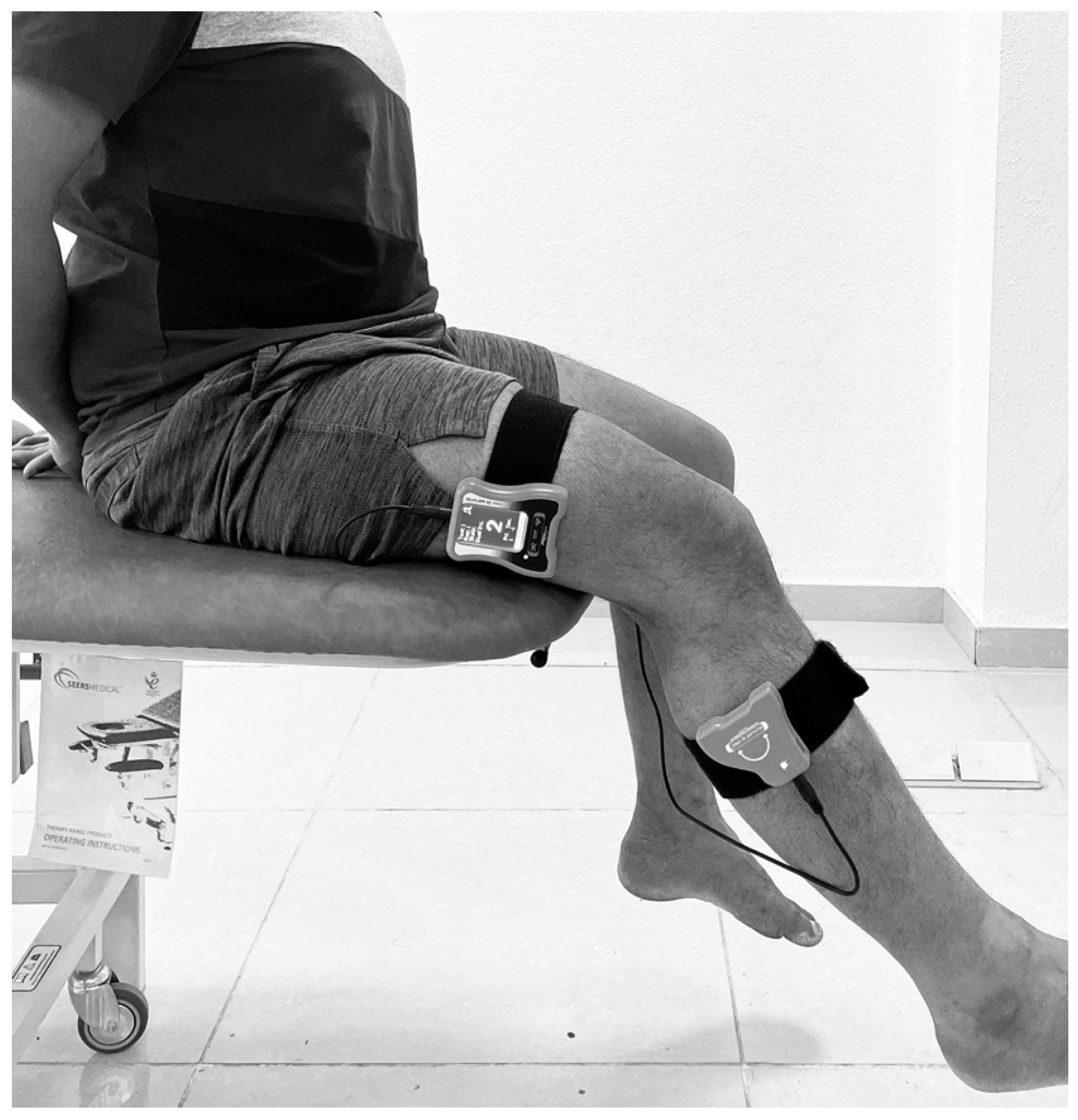
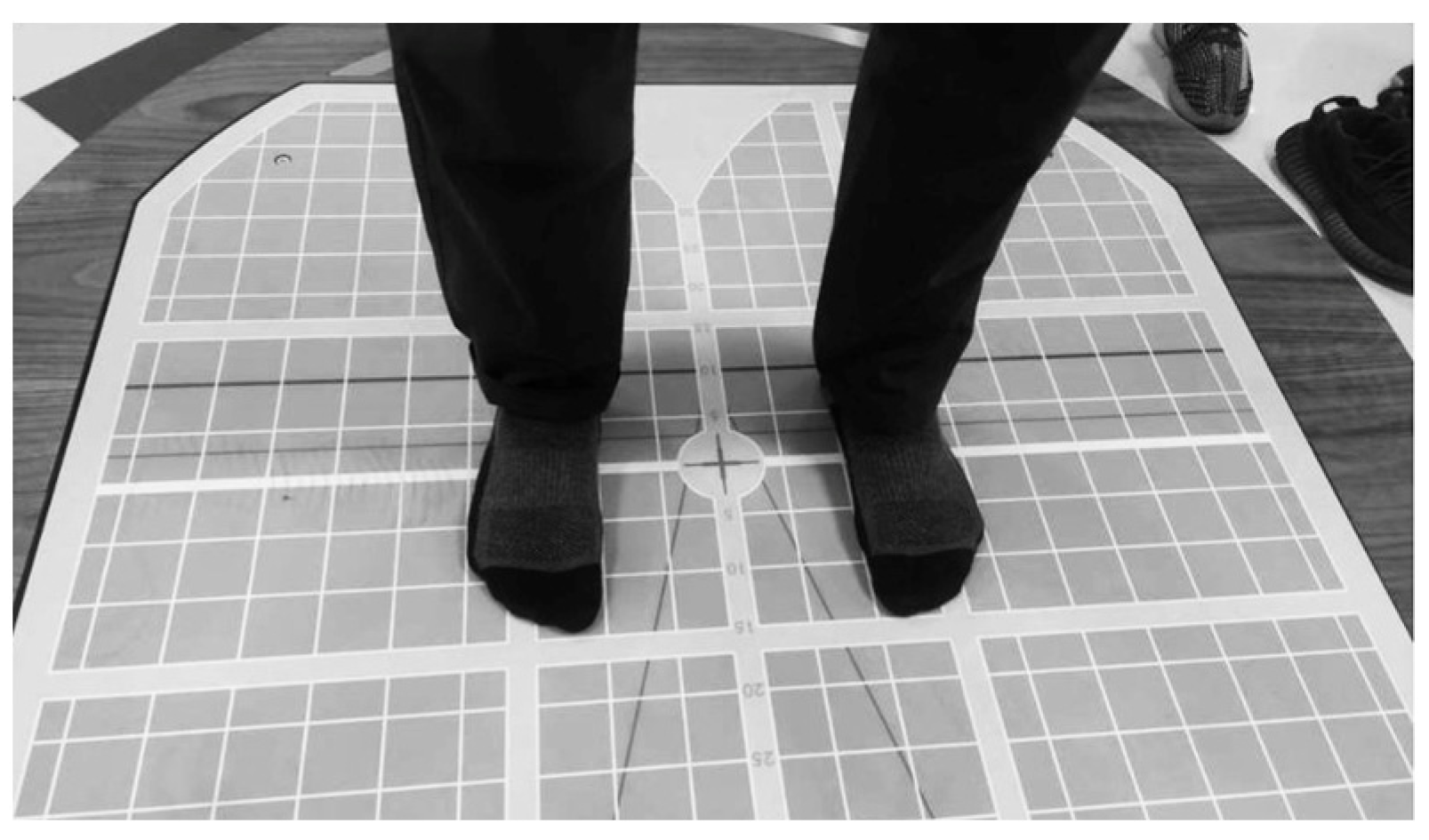
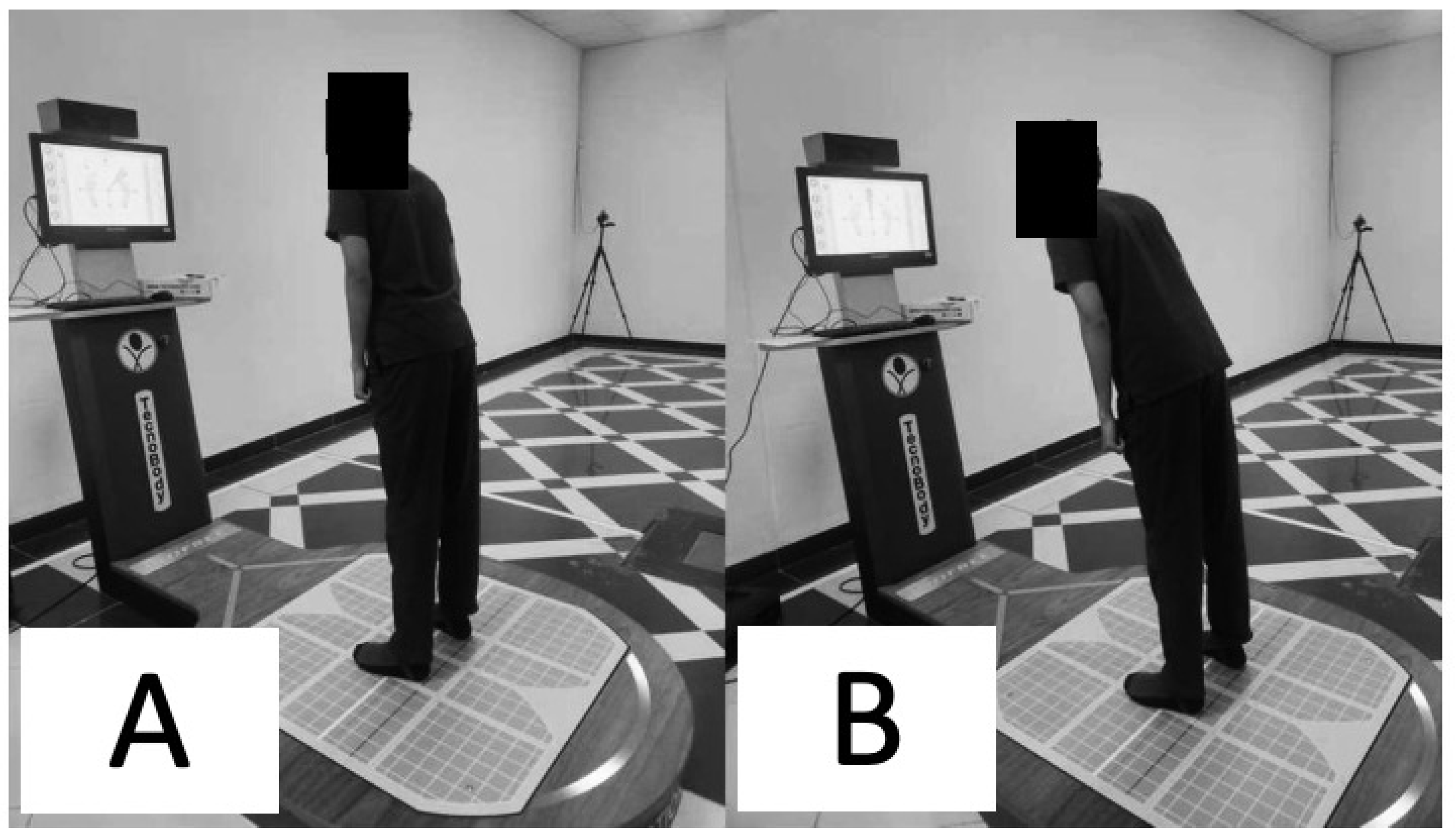
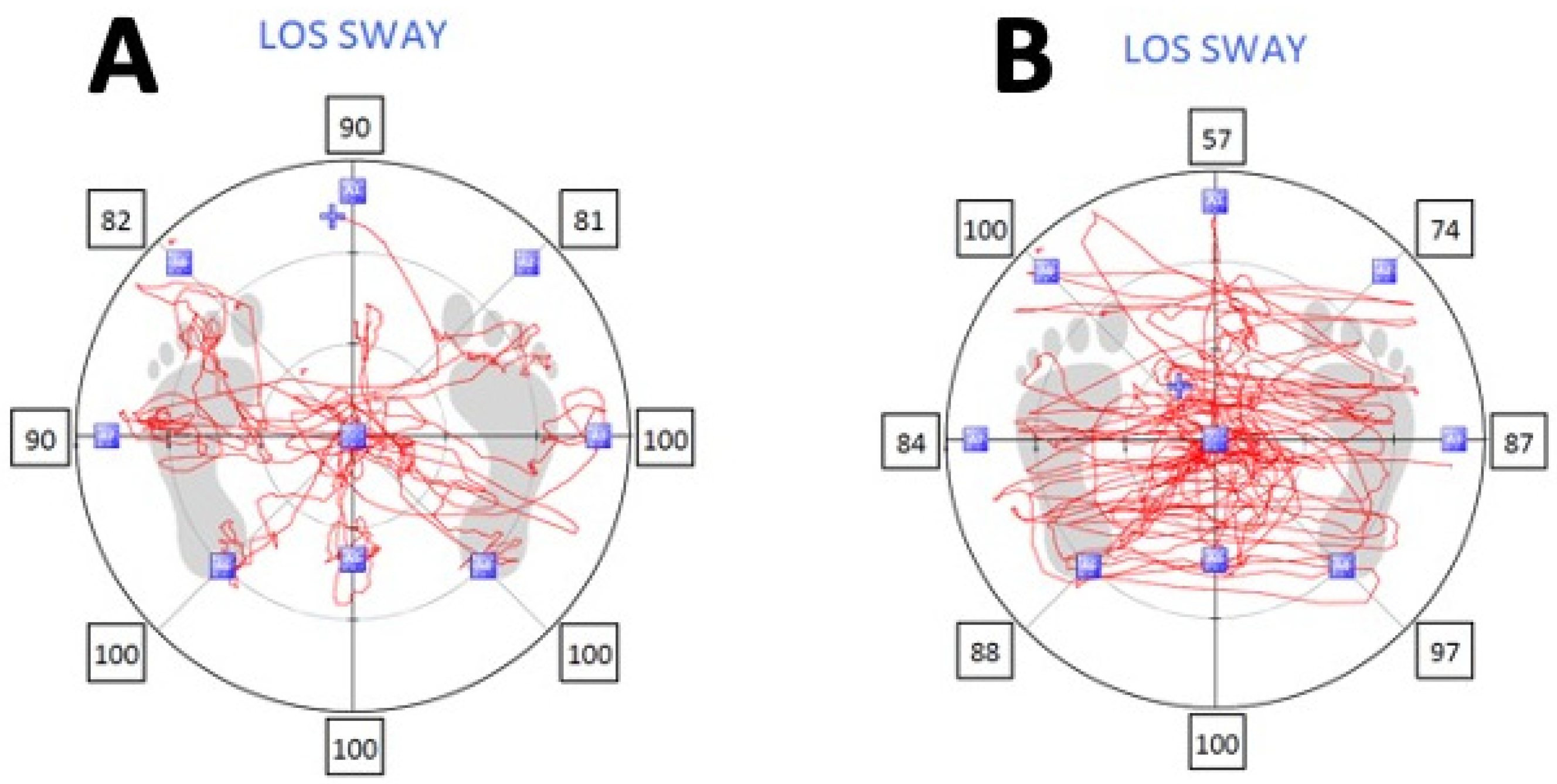
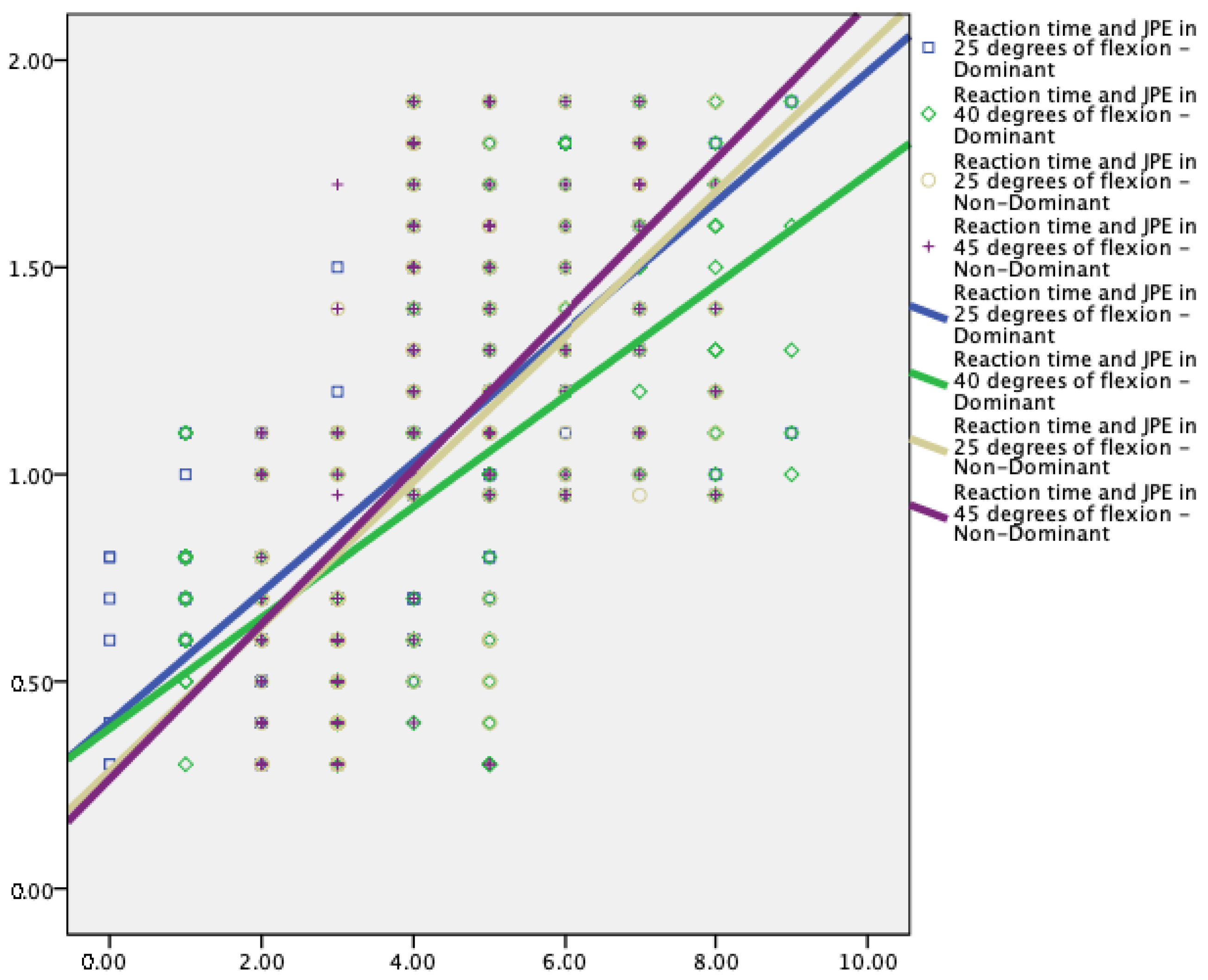
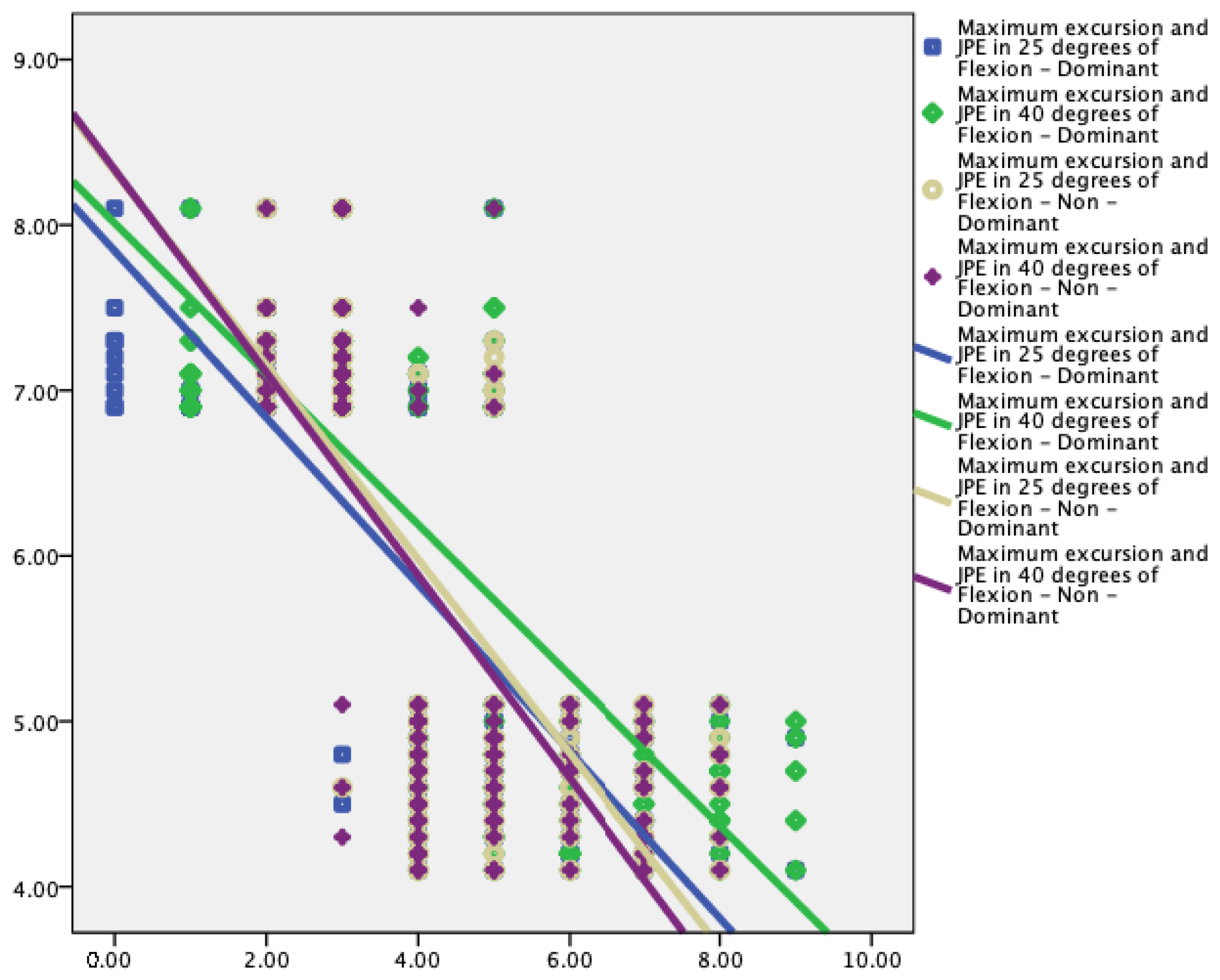
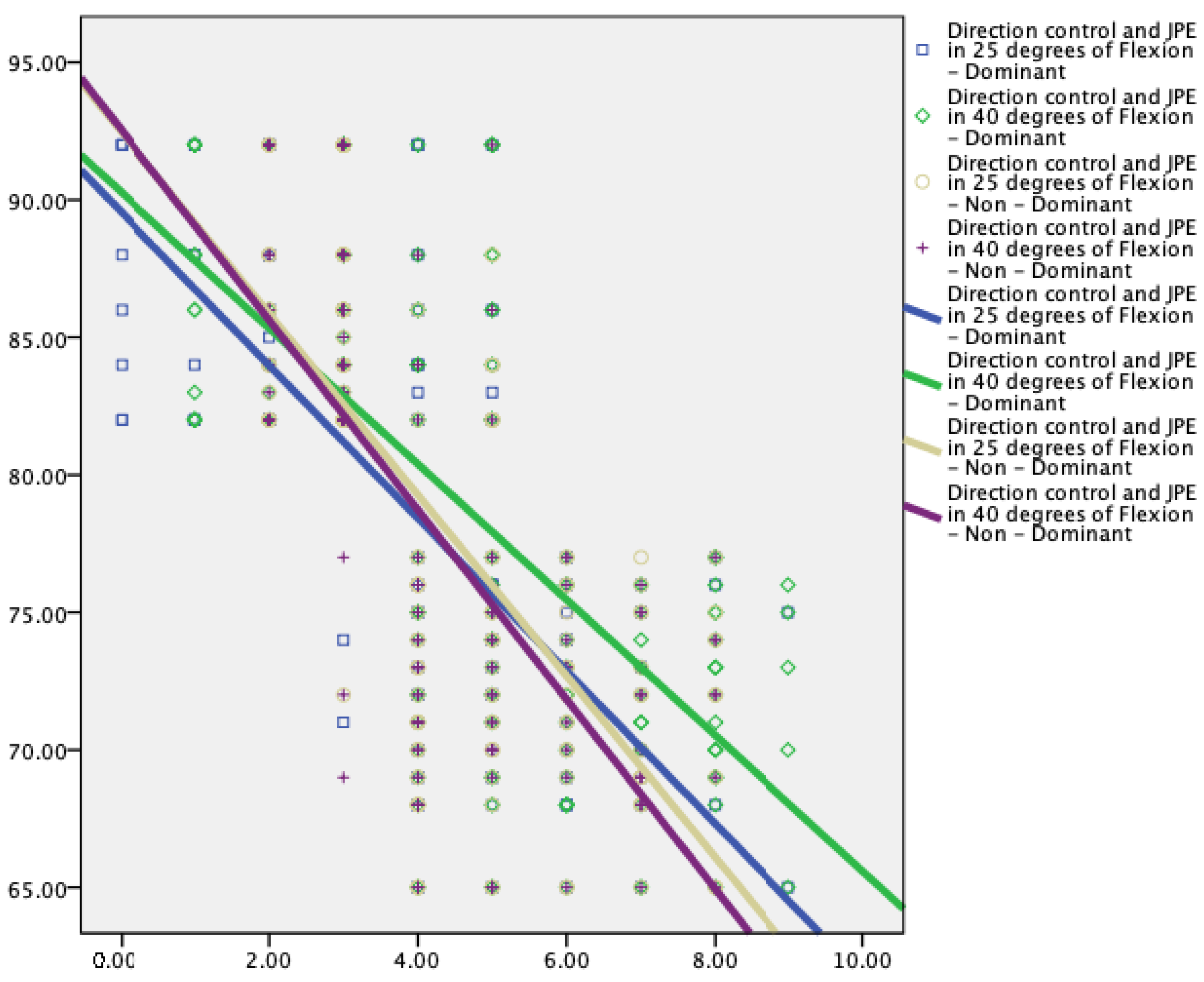
| Variables | Knee OA (n = 50) | Asymptomatic (n = 50) | p-Value |
|---|---|---|---|
| Age (years) | 67.10 ± 4.36 | 66.50 ± 3.63 | 0.475 |
| Gender (M:F) | 28:22 | 32:18 | 0.143 |
| Height (meters) | 1.67 ± 0.09 | 1.73 ± 0.05 | 0.302 |
| Weight (kg) | 71.34 ± 5.96 | 70.58 ± 5.24 | 0.130 |
| BMI (kg/m2) | 24.40 ± 3.50 | 23.38 ± 2.14 | 0.441 |
| Pain intensity (VAS score, 0–10) | 5.99 ± 1.70 | n/a | - |
| Knee Society knee score | 48 ± 13 | n/a | - |
| Variables | Asymptomatic (n = 50) | Knee OA (n = 50) | F | p-Value |
|---|---|---|---|---|
| Dominant—knee JPE at 25° of flexion (°) | 3.56 ± 1.05 | 5.48 ± 1.53 | 53.50 | <0.001 |
| Dominant—knee JPE at 40° of flexion (°) | 3.60 ± 0.86 | 5.40 ± 1.60 | 49.00 | <0.001 |
| Nondominant—knee JPE at 25° of flexion (°) | 3.68 ± 0.79 | 5.83 ±1.53 | 77.47 | <0.001 |
| Nondominant—knee JPE at 40° of flexion (°) | 3.44 ± 0.86 | 5.85 ± 1.57 | 90.66 | <0.001 |
| Reaction time (s) | 0.89 ± 0.29 | 1.64 ±0.30 | 162.48 | <0.001 |
| Maximum excursion (%) | 5.25 ± 1.34 | 4.37 ± 0.45 | 19.44 | <0.001 |
| Direction control (%) | 87.50 ± 4.49 | 78.42 ± 5.47 | 82.36 | <0.001 |
| Variables | Reaction Time (s) | Maximum Excursion (%) | Direction Control (%) | |
|---|---|---|---|---|
| Dominant—Knee JPE at 25° of flexion (°) | r | 0.68 ** | −0.28 ** | −0.60 ** |
| Dominant—Knee JPE at 40° of flexion (°) | r | 0.60 ** | −0.30 ** | −0.59 ** |
| Nondominant—Knee JPE at 25° of flexion (°) | r | 0.66 ** | −0.34 ** | −0.62 ** |
| Non- Dominant—Knee JPE at 40° of flexion (°) | r | 0.68 ** | −0.38 ** | −0.65 ** |
Disclaimer/Publisher’s Note: The statements, opinions and data contained in all publications are solely those of the individual author(s) and contributor(s) and not of MDPI and/or the editor(s). MDPI and/or the editor(s) disclaim responsibility for any injury to people or property resulting from any ideas, methods, instructions or products referred to in the content. |
© 2023 by the authors. Licensee MDPI, Basel, Switzerland. This article is an open access article distributed under the terms and conditions of the Creative Commons Attribution (CC BY) license (https://creativecommons.org/licenses/by/4.0/).
Share and Cite
Raizah, A.; Reddy, R.S.; Alshahrani, M.S.; Tedla, J.S.; Dixit, S.; Gular, K.; Gautam, A.P.; Ahmad, I.; Kandakurti, P.K. Investigating Knee Joint Proprioception and Its Impact on Limits of Stability Using Dynamic Posturography in Individuals with Bilateral Knee Osteoarthritis—A Cross-Sectional Study of Comparisons and Correlations. J. Clin. Med. 2023, 12, 2764. https://doi.org/10.3390/jcm12082764
Raizah A, Reddy RS, Alshahrani MS, Tedla JS, Dixit S, Gular K, Gautam AP, Ahmad I, Kandakurti PK. Investigating Knee Joint Proprioception and Its Impact on Limits of Stability Using Dynamic Posturography in Individuals with Bilateral Knee Osteoarthritis—A Cross-Sectional Study of Comparisons and Correlations. Journal of Clinical Medicine. 2023; 12(8):2764. https://doi.org/10.3390/jcm12082764
Chicago/Turabian StyleRaizah, Abdullah, Ravi Shankar Reddy, Mastour Saeed Alshahrani, Jaya Shanker Tedla, Snehil Dixit, Kumar Gular, Ajay Prashad Gautam, Irshad Ahmad, and Praveen Kumar Kandakurti. 2023. "Investigating Knee Joint Proprioception and Its Impact on Limits of Stability Using Dynamic Posturography in Individuals with Bilateral Knee Osteoarthritis—A Cross-Sectional Study of Comparisons and Correlations" Journal of Clinical Medicine 12, no. 8: 2764. https://doi.org/10.3390/jcm12082764
APA StyleRaizah, A., Reddy, R. S., Alshahrani, M. S., Tedla, J. S., Dixit, S., Gular, K., Gautam, A. P., Ahmad, I., & Kandakurti, P. K. (2023). Investigating Knee Joint Proprioception and Its Impact on Limits of Stability Using Dynamic Posturography in Individuals with Bilateral Knee Osteoarthritis—A Cross-Sectional Study of Comparisons and Correlations. Journal of Clinical Medicine, 12(8), 2764. https://doi.org/10.3390/jcm12082764








